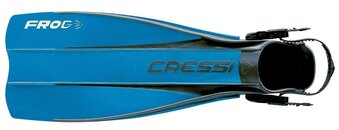I did an 800M swim in jets and was faster than anyone for the first 200M and lost the race in the end, then I put on some long splits and won the rematch.
I like my splits for mellow frog kicking (more thrust with less energy than flutter). I can not swim backward with my splits. For current I take my jet/paddle fins. Tried some really long spearfishing fins with dive gear and must not have had the right kick because I hated them yet the speros swear by them. really depends on how you kick a fin.
Sail,
What you have described above is the essence of the modern problem of how divers and dive educators view fins and propulsion. Clearly, a paddle fin with a stiffer blade is going to move more water and this will require more work from the diver, but the performance is better. When your muscles weren't tired, your athletic ability and fin design put you out front, but as you fatigued, you began to fall behind. If you trained regularly in Jet fins, you would strengthen your endurance. As a former marine, I know you could easily train up to the point where you'd decimate your competition while wearing Jets. Many Force Recon guys develop propulsion with Jets and other paddle fins - even when wearing boots, BDU's and carrying weapons and rucks.
For dive pros or others who may be called upon to rescue another diver, especially those with a duty to act, it is important to be able to swim fast and hard and to train up to the standards expected. Many divers complete timed swims for dive master and instructor levels and never do them again. If anything, such swims serve as a wake up call for our need as divers, dive masters and instructors to maintain high levels of fitness.
I routinely use OMS Slipstream fins, ScubaPro Jet fins, and Picasso America Black Team fins for all my diving needs. Each fin requires training time to build strength. After a 1999 car accident in which I was struck by a car at 40 - 50 m.p.h. on Cayman Brac, putting my freediving fins on while rehabbing was sometimes agonizing. I would switch to snorkeling fins when my ligaments and recovering muscles couldn't take any more punishment in a day, but I knew that I would have to endure to build endurance again.
I get to experience using a wide range of fins in my diving career. I've been forced to wear split fins at Disney. I often swap fins with my intro to tech and cavern/intro to cave students and I am shocked by the poor performance of many fins.
Regarding the OP, split fins are often thrown at newbie divers as part of a solution to the over all lack of quality found at most dive centers. It takes time to properly weight a student, so many students are overweighted or they are weighted properly once and not continually weighted throughout class as their breathing and level of comfort improves. Classes are done in such little time that the student doesn't have time to make noticeable improvement in breathing, buoyancy or swimming improvement. Part of longer scuba training is the development of a STRONG KICK prior to entering open water. Gear is designed to provide equipment solutions to the skills problems of divers and is used as a short cut and cop out to building the skills needed for using the most basic tools. Purge valves in masks and snorkels and split floppy blades may make diving easier, but the trade offs have consequences. Purge valves can leak and ruin a dive day or trip and split fins and weak kicks may create diver stress when currents or conditions requiring hard swimming arise.
People spend hard earned money on what they believe is the best instruction and equipment and they are let down much of the time by dive center staff and instructors who no longer even know that what they sell and the way they train is inferior.
One of the most useful tools in my kicking toolbox is my backward kick. I can do that kick in long blade freediving fins while breath hold diving. I can backward kick without fins and while sitting on my surfboard. I teach that kick to all my students in every class whether open water or cave. I can't do it in split fins. For that reason alone I wouldn't recommend them. However, fins are tools. Like Sail describes, he uses different tools for different jobs. I think experienced divers may decide to use splits for certain things. The problem is that new divers are not yet able to make such decisions and split fins short change them on being taught to kick backwards and to having their kicking technique, performance and endurance strengthened during class and at the beginning of their diving careers.
Lastly, you never know where new divers will end up going. They may end up tech, cave, pro or public safety. Why not just sell them the only fin they may ever need? That will develop trust right away between student, instructor and dive center.
Imagine how a student you just sold split fins to would feel after reading ScubaBoard and reading that the divers on the top of the totem pole of tech and cave diving hate split fins!




